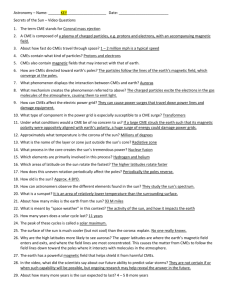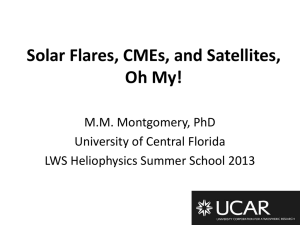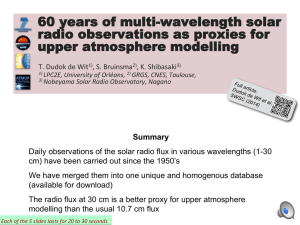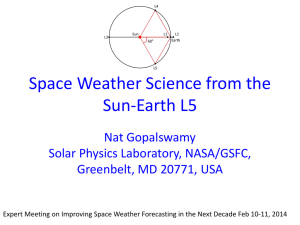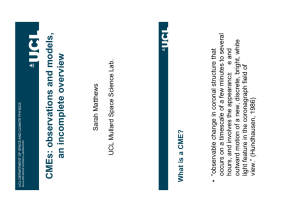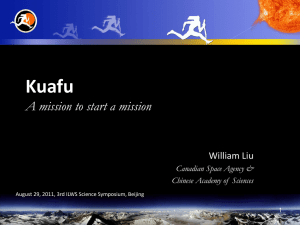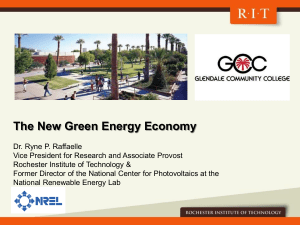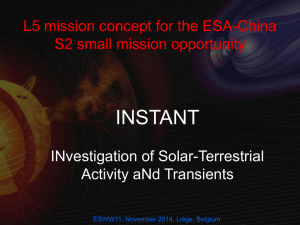PPT
advertisement
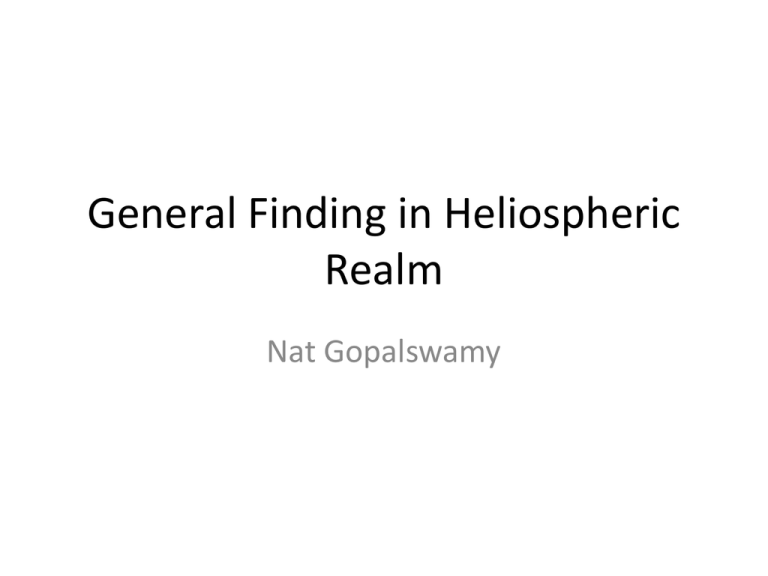
General Finding in Heliospheric Realm Nat Gopalswamy William Liu: Kuafu • Kuafu A @ L1(Ly-alpha imager, Ly-alpha + inner coronagraph, outer coronagraph); 3axis, 722 kg total; 130 kg payload • Kuafu B in double Molnya orbit (auroral arcs, vortices, turbulence) – anticipated • Kuafu A in 2016; B in 2019 (Liu’s recommendation) • Surface to 20 Rs coronagraph (WCOR + Ly alpha) only: Balanced Kuafu? SPORT (Solar Polar Orbit Radio Telescope ) Mission The Mission: Main Objective: Imaging & tracking interplanetary CMEs propagation Orbit: out-of-ecliptic (inclination > 73.45o) Attitude: 3-x stabilized Main payload: Synthetic aperture radio telescope (with ‘clock scan’ scheme) Frequency: 150±10MHz Angular Resolution: 2º Imaging Period: 30~60 mins FOV: ±25º Other Payloads: Imaging Payloads: Heliospheric Imager, chronograph, XEUV imagers, + .. In-situ Measurement Package: solar wind plasma detectors (both ion and electrons), energetic particle detector, fluxgate magnetometer, low frequency wave detector, solar radio burst spectrometer Launch Big Ellipse Transfer Jupiter Gravity Assist Sun Solar Polar Orbit Wu, Liu (Babcock- Leighton type) dynamo based solar cycle prediction: (Proper) magnetic memory in the dynamo required main diff. (Proper) approach to derive between two the poloidal source from predictions observation Tricky, important … problem !! Generation of poloidal field: nonlinear effects to modulate & Random effects (Jiang) Kinematics and coronal field strength of an untwisting jet in a polar coronal hole observed by SDO/AIA Huadong Chen, Jun Zhang, & Suli Ma AIA 304 (a) MF1(06:31 - 06:36 UT) MF3 (06:36 - 06:40 UT) 10 Mm The main results are: 1. By tracking six moving features (MF1-6) in the jet, the kinematics (axial velocity, transverse velocity, angular speed, rotation period and rotation radius) of the untwisting jet are 1 obtained. v 1 1 4 k m s (06:32 - 06:36 UT) MF2 (06:26 - 06:29 UT) MF4 MF5 (06:33 - 06:36 UT) MF6 (06:30 - 06:34 UT) a 1 v 1 3 6 k m s t 1 31 0 . 8 1 s ( o r 1 4 . 1 1 0 r a d s ) T 4 5 2 s ( t w i s t 3 . 6 t u r n s ) 3 A 9 . 8 1 0 k m • 06:38:56 UT (b) MF2 Time from 06:32:44 UT to 06:36:32 UT 2. On assumption of the magnetic flux conservation in the same flux tube, we estimate the coronal field strength in the polar coronal hole. Our results show that the coronal flux density at the heights of 10~70 Mm decreased from about 15 to 3 0 . 8 4 B 0 . 5 ( R / R 1 ) ( G ) G. A formula of fits our estimated data well. Also current sheet by Zhao S.-L. Ma • Comparison of CME and ICME fluxes (independently measured for 9 events; Qiu et al., 2007): - flare-associated CMEs and flux-rope ICMEs with one-to-one correspondence; - reasonable flux-rope solutions satisfying diagnostic measures; - an effective length L=1 AU (uncertainty range 0.5-2 AU) . GS method Leamon et al. 04 Lynch et al. 05 P ~ r Q. Hu 7 Prominence Signature in MCs High Np and low Tp Located at the center of the flux rope Existence of He+ Heating before and after prominence material HELIOS Events: 1979DOY129, at 0.3 AU 1976 DOY 90, at 0.5 AU 1978DOY358, at 0.7 AU Model In situ measurement SOHO NASA Remote Observation Gopalswamy SpaceSciRev, 2006 Yao et al., 2010, JGR 8 Understanding Solar Minimum 23-24 • Characterized by a large number of sunspot-less days (No cycle overlap) and a weak polar field strength. Surface Magnetic Field Latitude MF Amplitude • Meridional Flow (MF) amplitude was varied from cycle to cycle. Time Polar Field • A meridional flow speed which goes from fast to slow reproduces the observed solar minimum characteristics • The strength of the polar field is governed mainly by surface dynamics in the early half of the cycle. Overlap • The amount of spotless days is governed by the dynamics deep in the solar interior. Nandy, Muñoz-Jaramillo & Martens, Nature, 471, 80 (2010). Forecasting the solar minimum using kinematic dynamo models • Kinematic dynamo models have been used for the first time to make solar cycle predictions, but the two model based predictions are very different. • The reason behind the difference is related to solar cycle memory (Yeates, Nandy & Mackay 2008): • Diffusion dominated: one cycle. • Advection dominated: several cycles. Diffusion dominated Choudhuri et al. (2007) Advection dominated Dikpati et al. (2006) • There are still outstanding issues regarding magnetic flux transport: • Uncertainties in turbulent diffusivity (Muñoz-Jaramillo, Nandy & Martens 2011). • Lack of turbulent downward flux-pumping (Guererro & De Gouveia Dal Pino 2008). • Taking these issues into consideration suggests that cycle memory is only one cycle regardless of the type of model (Nandy & Karak, in preparation). CME Interaction, Lugaz The “twin-CME” scenario IT IS VERY LIKELY THAT SPACE-HARZARD EVENTS ARE CAUSED BY “TWIN-CMES” WHERE TWO CMES OCCUR CLOSELY IN TIME (9 HOURS) FROM THE SAME ACTIVE REGION. Recipe for GLE event 1) first CME/shock setup a strong turbulence upstream the second CME/shock. 2) open closed magnetic reconnection brings out driver material which is heavy ion rich. 3) the second shock has to go through the turbulence-enhanced region. Gang Li This give us a very powerful predictability on Space weather! AIMOS - Model conception Atmospheric Ionization Module OSnabrück (http://aimos.physik.uos.de) horizontal pattern: empirical model based on satellite data and Kp -> particle distribution on top of atmosphere vertical pattern: numerical model Monte-Carlo simulation -> ionization of single particle injections empirical model + numerical model -> atmospheric ionization of full particle inventory, worldwide, continuous from 2002 AIMOS - results Accuracy Benefits AIMOS+GCM vs. measurements here: electron density compared to radars without particles el. density in high atmosphere compared to radars NOy in lower atmosphere compared to MIPAS with particles Kperp/kpar = 10% Wimmer • • • • • • • • • • • • • • EP production chain observations DC, stochastic & shock accelerations DC: E = 0.2 V/m (motion of B field causes an electric filed E~ vB) current sheet ~5000 km; acceleration in RC islands? Stochastic: consequence of wave-particle interaction w – k.V = n.omega shock: diffusive, shock-drift diff: VsxB is the electric field that accelerates April 3 2010 event: STA SEP flux an order of mag higher than in STB Rouillard et al. (2011) use ENLIL to explain SEP variation Lario et al. (2005) not all shocks accelerate particles. Seed particles is a key. M>3 always accelerate Vainio model propagation: diffusive, focused, scatter-free Kahler 2007 Kallenrode & Wibberenz model very important (helios data & IMP data) Jan Maik Wissing • • • • • • aurora ionization secondaries bremsstrahlung (e) cosmogenic isotope production mag particles: 10 keV to MeV (deposit above 90 km) • SEP reach down to 20 km • GLEs even below Wissing (continued) • • • • • • • • • • • • polar cap SEP events: ionization dominated by protons Wissing and Kallenrode 2009 higher conductivity, chemical reaction – Hox, Nox, Ozone depletion N2, O2, NO, O dissociated forming Hox and Nox NO + O3 Rohnen et al. 2005 North-south asymmetry: transport of Nox in the winter hemispere SEP impact similar to UV rad over the solar cycle Low cloud (<3.2 km) correlates with GCR Markson, 1978 Singh, Singh, Kamra, 2004 Model: Determine particle flux above the atm; calaculate energy dep; Wissing et al., 2011 • Good models for polar cap; not accurate in the oval Ho (gang li) • • • • • • Sugiyama & terasawa 1999 CME needs to be around 5 Rs for producing GLEs Drury 1983 dt = 3skdp/(s-1)u^2 p need small k Tylka 2005 Presence of preceding CMEs: All of the GLEs have preceding CMEs (Li et a., 2011) • Ding et al., 2011 Guhathakurta: SW impact • 100 M$ satellite, 100 M$ power grids, 10 M$ communications • humans in space, crew on passengers • Cliver & Svalgaard 2004 • lowest lat aurora in 1872 • Biggest storm in 1989 March • transit 14 h on 4 Aug 1972 9between two Apollo flights) • NSWP since 1995; NOAA SWPC; Guhathakurta (continued) • Flares (R5): X20 (once per cycle) Nov 4, 2003: X28+, April 2, 2001: X20 • Storms (G5): K9, 4 per cycle lowlat aurora, outage, pipeline currents reach 100s of A • SEPs: (S5) 10000 pfu <1 per cycle • 9 events since 1976 • S5 and R5 are truly seldom; G5 less useful • 1000 to 100000 times greater than X1 in stars – 10-20 days rotation period (Schrijver) Alexi Glover • satellites: particle, plasma • humans: iss, future ip missions • Lack of flares: build up of debris in LEO & reduced orbital drag • large gcr flux for crewed missions and some sensitive electronics • euro crews treated as radiation workers (high latitude, polar flights) – legal responsibility • Integrity of GNSS may be compromised Lugaz • Tracking CMEs to 1 AU, CME-CME interaction YM Wang • Source identification of Rise 23 CMEs – 19% of CMEs missed by LASCO, similar to what Yashiro et al. (2005) found. • brightness is ppl to apparent speed bright feature = compressed solar wind Suli Ma • 11/32 stealth CMEs during unusual minimum • speed: lower speed (50 – 100 km/s) compared to the ones with LCS (Jan 1-Aug 31, 2009) • a – small in COR2 FOV; not different • Limb events do show EUV changes in the inner corona Suli Ma Shock • • • • • • 6/13/2010 event T ~ 3 MK Sheath bright in 193; dark in 171 Bubble flux rope Vs 600 km/s; bubble 410 km/s shock speed decrease: 600 to 550 km a -1 km/s/s • Flare 5:36 – peak 5:39 UT • Shock coincides with the fastest part • compression ratio: 1.56 Zhao • Current sheet behind CMEs Hu • Grad-Sharanov reconstruction of MC structure • Phi-r (flare) ~ phi-p (MC); Quantitative CME – ICME connection Shuo Yao • • • • • • • • • Good review of CME substructures Id three-part structure in in-situ observations three case studies at 0.3, .5, .7 AU from Helios Heating before and after the prom material High Np, Low Tp (similar to prom), possibly He+ (Yao et al., 2010) Solwind CME 600 km/s travels to .3 AU in 22 h (helios 2) doy 90, 1976 0.5 AU; He+; heated plasma before and after the cold feature 0.7 AU All signatures observed Solar probe plus, Solar Orbiter OPgenoorth • Interaction of CMEs and CIRs with Mars ionosphere (MARSIS) – 12 events • CME and CIR related dynamic pressure variations; induced magnetosphere • Kozyra talk; Zhang
